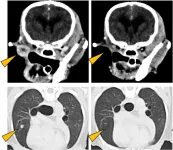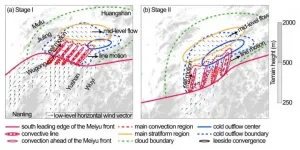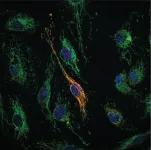Artificial intelligence model predicts which key of the immune system opens the locks of coronavirus
2021-04-22
(Press-News.org) The human immune defense is based on the ability of white blood cells to accurately identify disease-causing pathogens and to initiate a defense reaction against them. The immune defense is able to recall the pathogens it has encountered previously, on which, for example, the effectiveness of vaccines is based. Thus, the immune defense the most accurate patient record system that carries a history of all pathogens an individual has faced. This information however has previously been difficult to obtain from patient samples.
The learning immune system can be roughly divided into two parts, of which B cells are responsible for producing antibodies against pathogens, while T cells are responsible for destroying their targets. The measurement of antibodies by traditional laboratory methods is relatively simple, which is why antibodies already have several uses in healthcare.
"Although it is known that the role of T cells in the defense response against for example viruses and cancer is essential, identifying the targets of T cells has been difficult despite extensive research," says Satu Mustjoki, Professor of Translational Hematology.
AI helps to identify new key-lock pairs
T cells identify their targets in a key and a lock principle, where the key is the T cell receptor on the surface of the T cell and the key is the protein presented on the surface of an infected cell. An individual is estimated to carry more different T cell keys than there are stars in the Milky Way, making the mapping of T cell targets with laboratory techniques cumbersome.
Researchers at Aalto University and the University of Helsinki have therefore studied previously profiled key-lock pairs and were able to create an AI model that can predict targets for previously unmapped T cells.
"The AI model we created is flexible and is applicable to every possible pathogen - as long as we have enough experimentally produced key-lock pairs. For example, we were quickly able to apply our model to coronavirus SARS-CoV-2 when a sufficient number of such pairs were available," explains Emmi Jokinen, M.Sc. and a Ph.D. student at Aalto University.
The results of the study help us to understand how a T cell applies different parts of its key to identify its locks. The researchers studied which T cells recognize common viruses such as influenza-, HI-, and hepatitis B -virus. The researchers also used their tool to analyze the role of T-cells recognizing hepatitis B, which had lost their killing ability after the progression of hepatitis to hepatic cell cancer.
The study has been published in the scientific journal PLOS Computational Biology.
A new life for published data with novel AI models
Tools generated by AI are cost-effective research topics.
"With the help of these tools, we are able to make better use of the already published vast patient cohorts and gain additional understanding of them," points out Harri Lähdesmäki, Professor of Computational Biology and Machine Learning at Aalto University.
Using the artificial intelligence tool, the researchers have figured out, among other things, how the intensity of the defense reaction relates to its target in different disease states, which would not have been possible without this study.
"For example, in addition to COVID19 infection, we have investigated the role of the defense system in the development of various autoimmune disorders and explained why some cancer patients benefit from new drugs and some do not", reveals M.D. Jani Huuhtanen, a Ph.D. student at the University of Helsinki, about the upcoming work with the new model.
INFORMATION:
ELSE PRESS RELEASES FROM THIS DATE:
2021-04-22
The study was published by the team from Ruhr-Universität Bochum (RUB), the Max Planck Institutes of Biochemistry and Biophysics, the Center for Synthetic Microbiology (SYNMIKRO) and the Chemistry Department at Philipps Universität Marburg, the University of Illinois Urbana-Champaign, USA, and Université Paris-Saclay, France, online on 12 April 2021 in the journal Nature Plants.
Catalyst of life
Photosystem II (PS II) is of fundamental importance for life, as it is able to catalyse the splitting of water. The oxygen released in this reaction allows us to breathe. In addition, PS II converts light energy ...
2021-04-22
Scientists have shown that the biological molecule PD-L1 is a potential target for the treatment of metastasized oral malignant melanoma in dogs.
There are a number of cancers that affect dogs, but there are far fewer diagnosis and treatment options for these canine cancers. However, as dogs and humans are both mammals, it is likely that strategies and treatments for cancers in humans can be used for canine cancer, with minor modifications.
A team of scientists, including Associate Professor Satoru Konnai from the Faculty of Veterinary Medicine at Hokkaido University, have demonstrated that an anti-cancer therapy that targets the cancer marker PD-L1--a target that has shown great promise for treating cancer in humans--is ...
2021-04-22
Notch proteins are key regulators of growth and differentiation of both normal and cancer cells. Researchers in Turku, Finland, have now demonstrated that the activities of distinct Notch family members are modified differently by phosphorylation. These results can be used in the development of new cancer treatments, especially for hormone-dependent breast cancer.
Breast cancer is the most common type of cancer in women in Finland and other Western countries. Due to the availability of hormonal therapies, the estrogen-responsive breast cancer cases have a relatively good prognosis as compared to other breast cancer subtypes. However, some of them can also develop into an aggressive, metastatic disease, for which new types ...
2021-04-22
New research by the University of New England's Palaeoscience Research Centre suggests juvenile tyrannosaurs were slenderer and relatively faster for their body size compared to their multi-tonne parents.
The research, published in the END ...
2021-04-22
Thunderstorm development is not always dependent on atmospheric physics alone. Often, the surrounding landscape can influence convection, especially in regions with dramatic elevation changes. The Yangtze river basin in China's Jiangxi Province, which is surrounded by the Nanling Mountains, often experiences mesoscale convective systems (MCS) or squall line thunderstorms during the summer. These MCSs develop along the persistent mei-yu front, and often exhibit quickly developing parallel back-building, or training thunderstorms, resulting in torrential flooding. A research team led by Dr. Zhemin Tan, Professor at the School of Atmospheric Sciences of Nanjing University, analyzed the influences of the regional landscape that lead to consistent MCS back-building ...
2021-04-22
SINGAPORE, 22 April 2021 - A multidisciplinary team of researchers from Duke-NUS Medical School and the Agency for Science, Technology and Research (A*STAR) in Singapore discovered a new mitochondrial peptide called MOCCI that plays an important role in regulating inflammation of blood vessel and immunity. The study, published in the journal Nature Communications, revealed how one gene encoded two molecules that provide two-pronged protection following viral infection.
Chronic and excessive inflammation of the blood vessels, known as vascular inflammation, can lead to tissue damage and cardiovascular diseases such as atherosclerosis and fibrosis. Although some therapies have shown promising results in clinical trials, they have considerable side effects, such as immunosuppression ...
2021-04-22
An increasing number of young women are at increased risk of having children born with impaired neurological conditions, due to poor iodine intake.
Dietary changes, including a growing trend towards the avoidance of bread and iodised salt, as well as a reduced intake of animal products containing iodine can contribute to low iodine levels.
A small pilot study undertaken by the University of South Australia (UniSA) comparing iodine levels between 31 vegan/plant-based participants and 26 omnivores has flagged the potential health risk.
Urine samples showed iodine readings of 44 ug/L in the plant-based group, compared to the meat eaters' 64 ug/L ...
2021-04-22
The week of Thanksgiving last year, a postcard arrived in mailboxes in Christiansburg. A link to a survey was on the back. On the front, there was a picture that was, by then, very familiar to the residents of a town that made history in 2019 as the first place in the U.S. to have a residential drone delivery service: a yellow-winged drone with a small cardboard box tucked underneath it.
The survey's 20 questions were designed to measure how Christiansburg's 22,000 residents felt about drone delivery -- the first time that this question had ever been posed to a community that had actually experienced the service. The survey was developed and conducted by researchers from the Virginia ...
2021-04-22
DALLAS, April 22, 2021 -- People with abdominal obesity and excess fat around the body's mid-section and organs have an increased risk of heart disease even if their body mass index (BMI) measurement is within a healthy weight range, according to a new Scientific Statement from the American Heart Association published today in the Association's flagship journal, Circulation.
"This scientific statement provides the most recent research and information on the relationship between obesity and obesity treatment in coronary heart disease, heart failure and arrhythmias," said Tiffany M. Powell-Wiley, M.D., ...
2021-04-22
When it comes to friendships and rivalries, male dolphins know who the good team players are. New findings, published in Nature Communications by University of Bristol researchers, reveal that male dolphins form a social concept of team membership based on cooperative investment in the team.
The Bristol researchers, with colleagues from the University of Zurich and University of Massachusetts, used 30 years of observational data from a dolphin population in Shark Bay, Western Australia, and sound playback experiments to assess how male dolphins responded to the calls of other males from their alliance network.
Dr Stephanie ...
LAST 30 PRESS RELEASES:
[Press-News.org] Artificial intelligence model predicts which key of the immune system opens the locks of coronavirus






